Asthma is a disease of the airways. Airways are the pipe/tube-like structures through which you breathe. In asthma, airways get swollen and secrete a sticky substance called mucus. Thus, the airway becomes narrow and you find it difficult to breathe.
Asthma is generally hereditary, which means it is passed through families. It does not spread from one person to another. it has nothing to do with how you were raised or your relationships or your social status. Asthma is treatable and you can keep symptoms well under control.
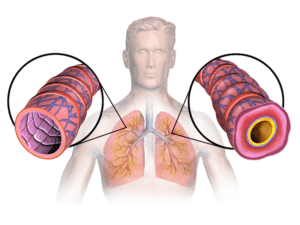
What happens when you have asthma?
| Normal airways | Asthmatic Airways | Asthmatic Airways During Attack |
|---|---|---|
| Normal airways are not swollen and the air can pass easily through them. | In asthma, the airways are swollen and narrowed, so breathing is not easy. Thus, patients develop episodes of coughing, shortness of breath and wheezing | In an asthma attack, windpipes are swollen, narrowed, and full of mucus, which makes airways tight, and the gets trapped in the alveoli. Thus, there is wheeze, cough, and difficulty in breathing. |
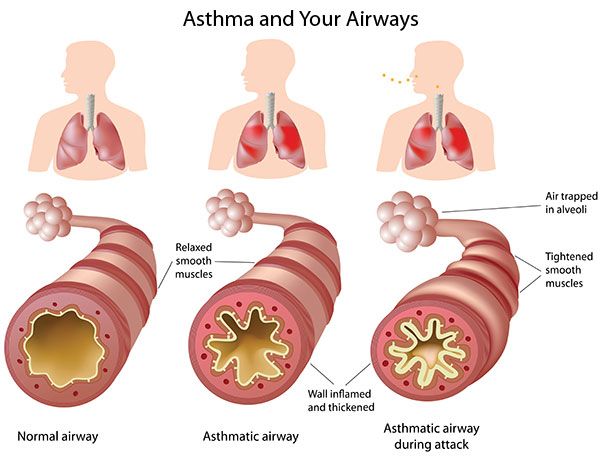
Asthma: Causes and Triggering Factors
Causes:
The exact cause of asthma is not known. It is more common if there is a family member with asthma or allergy. Symptoms of asthma may develop at any age.
- Allergens: Some substances like pollen from flowers, animal dander, hair of pets like cat and dog, etc. can trigger asthma
- Dust: Dust and dust mite are important risk factors
- Paint: Inhaling chemicals present in paints can trigger asthma in some people
- Exposure to cigarette smoke: Cigarette smoke is an important trigger to asthma. Cigarette smoke can not only directly increase risk of asthma but can also make a person more prone to viral infections and make airways more sensitive
- Occupational factors: Exposure to things like grains, flours, cleaning agents, metals, irritants, woods, etc. at the place may trigger asthma
- Overweight and obesity: Incidence of asthma is higher among patients who are overweight
- Pesticides: Exposure to pesticides and insecticides is associated with an increased risk of asthma
- Viral infections: Some viral infections which cause the common cold can trigger asthma
- GERD: GERD/gastroesophageal reflux disorder – a disease in which there is a possibility of regurgitation of stomach ingredients into the windpipe can trigger asthma
- Other triggers: Other triggering factors include stress, exercise, and air pollution.
Asthma: Symptoms and Feelings
Symptoms of asthma vary from patient-to-patient. In addition, the severity of symptoms may vary from patient-to-patient or depending on the severity of disease pathology. Everyone’s feeling about his condition or disease is different, they depend on their threshold of addressing challenges. Many patients describe their breathing as “breathing from the straw”.
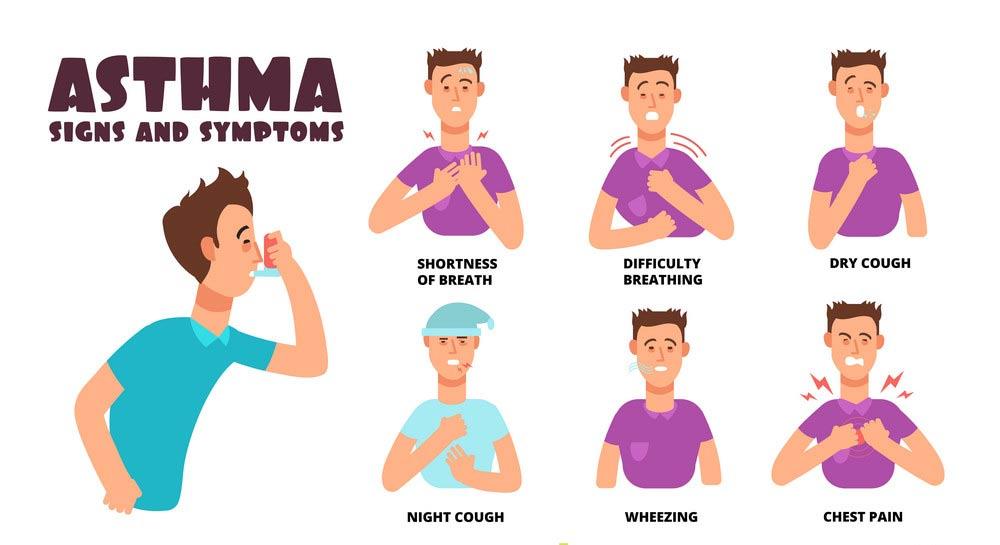
Asthma Attack
In asthma attack, you may experience one or more of the following:
- Your reliever medicine may not help you and you may need to use the medication more often
- You get a lot of wheezing, the chest is tight and you get a lot of coughs
- You are breathless and you may find it difficult to walk or talk
- You breathe faster and you feel as if you are not getting enough air
- Although rare, fingertips may become blue because of the non-availability of sufficient oxygen.
If you get asthma attack:
- Situ up straight
- Take your quick-relief medication
- Call an ambulance to reach the hospital or arrange transport to a nearby hospital
How do you feel when you have asthma?
You may feel discouraged when you are diagnosed with asthma. With asthma, you may have difficulty doing your regular work, exercise and it can hamper your sleep because of symptoms. Don’t be discouraged, asthma can be kept under control with proper medication and you can have a normal life and perform your daily activities without much problem.
Asthma is not an old age disease or a childhood disease or a smoker’s disease or wrath of God, it is just a condition where the immune system of your body overreacts to a trigger. It is important not to get guilty or stigmatized by asthma.
It is important that you educate yourself about the condition and take medicine without having any social stigma. After all, asthma is a condition that can be managed well with regular and effective medications.
Correct medication use in asthma
You are lucky, effective medicines are available.
Luckily, with medical advancements, we doctors know much more about asthma and its management now than ever before.
Although asthma can’t be completely cured, with better drugs available today, it surely can be kept under control for life-long and with the control, you can lead a life like non-asthmatic people. With good asthma control, like non-asthmatic people, you can –
- Have freedom from symptoms both during day and night
- Have the best possible lung function
- Can you do any physical activity of your choosing
- Can attend a school or work more or less every day
- Have fewer asthma attacks
- Have no or minimal medicine-related side-effects
Some Rules
To keep your asthma under control, you have to follow some rules. Here are a few of them :
- Discuss with your doctor about asthma and how to keep it under control. Educate yourself about the conditions.
- Make a plan for your asthma control in discussion with your doctor.
- Visit your doctor regularly as suggested by him.
- Learn which medicine to take, how to take, when to take, and the correct method of taking medication.
- In case if you are using a quick-relief inhaler, ask your doctor if you can add a spacer, as it will make use of drugs easy.
- Take all medicines as prescribed by your doctor.
- Identify the things that bring asthma symptoms in you and avoid them or at least reduce exposure to them.
- Keep a watch on changes in asthma. Learn to identify symptoms of an asthma attack, so that you can quickly take the required steps.
Inhaler Technique
It is important that you properly use an inhaler to ensure that the drug reaches the lungs. Following is the right inhaler technique.
Metered-Dose Inhaler (MDI)

Dry powder inhaler (DPI)

Inhaler with spacer
1. Open the inhaler
2. Shake the inhaler well
3. Connect the spacer keeping the cap towards you
4. Breath out completely
5. Put the tip of the spacer inside your mouth, press down the inhaler and breath in
6. Hold the breath for 10 sec
7. Breath out
8. Remove the spacer and cap the inhaler

Using steroid inhaler
1. Open the inhaler
2. Shake the inhaler well
3. Breath out completely
4. Breath in deeply through the inhaler
5. Hold the breath for 10 sec
6. Breath out
7. Cap the inhaler
8. Wash your mouth

Management of asthma
Lifestyle changes

Diet in asthma
Here are some dietary changes that are helpful in asthma management:
Have food rich in vitamin A and Vitamin D. Vitamin A and D make lung tissue stronger and thus helps to fight inflammation and allergy, which are characteristic of asthma. The foods rich in vitamin A include carrots, lettuce, sweet potatoes, fish, milk products, eggs, etc. Fish and milk are rich in vitamin D. Vitamin D is also produced by our body on exposure to sunlight.
Have a diet rich in Vitamin E. Vitamin E is an antioxidant that helps to fight inflammation. It is abundant in food like seeds, nuts, and vegetables.
Have polyunsaturated (very) long-chain fatty acids such as omega-3 PUFAs linolenic acid, eicosapentaenoic acid (EPA), and docosahexaenoic acid (DHA), and the omega-6 PUFAs are found to have beneficial effects in asthma. These are mainly found in seafood.
Avoid saturated fatty acids such as meat, cheese, ice cream, and dairy fat. They can trigger asthma and inflammation.
Avoid food with medium-chain fatty acids such as coconut oil, palm oil, etc. they are found to trigger asthma.
Exercise in asthma
Breathing exercises, especially those which involve holding breath are very helpful in asthma. Breathing exercises are done to decrease the rate and volume of breathing, to increase the use of lower abdominal muscles, to improve chest movements, to use nose for breathing, and to induce relaxation. Breathing exercise benefits you by decreasing over-breathing, decreasing breathlessness, decreasing inflammation, decreasing changes in the pattern of breathing, and decreasing anxiety.
Commonly used breath retaining exercises are as follows:
- Pursed-lip breathing
- Diaphragmatic breathing
- Inspiratory muscle training (IMT)
Pursed Lip Breathing: Sit upright, breathe in through the nose and slowly breathe out by making pursed-lip (like how you make your lips to blow a candle). The duration of breathing out should be at least twice as breathing in. The technique helps you to decrease the number of breaths taken in and keeps the airways open for a longer duration.
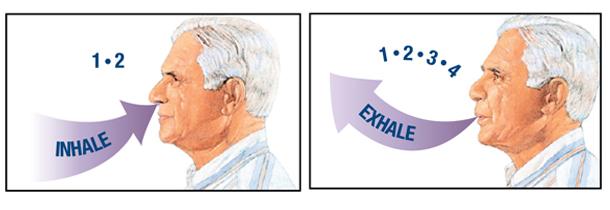
Diaphragmatic breathing: Lie-down on your back; keep your body relaxed; gently place your hands on your belly; breathe in slowly and breathe out slowly; breath using your belly instead of chest; observe raise and fall of belly as you breathe in and breathe out. Remember you should only use your belly to breathe; so, keep your shoulders, chest, and neck relaxed while doing this exercise.
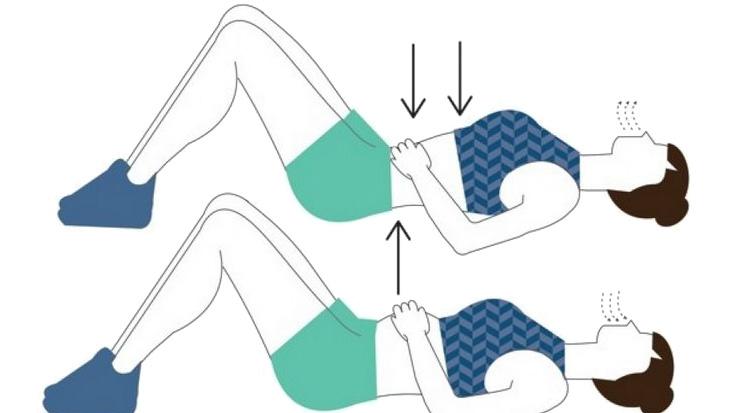

Inspiratory muscle training (IMT): Inspiratory muscle training is aimed at increasing the strength and stamina of accessory respiratory muscles and diaphragm. It usually involves breathing through a device. IMT helps to decrease oxygen consumption and to increase the strength of respiratory muscles. Please consult a therapist to learn this exercise.
Yoga for Asthma
Yoga is useful in various ways to improve asthma. Here are 8 yoga poses that are helpful in asthma management.


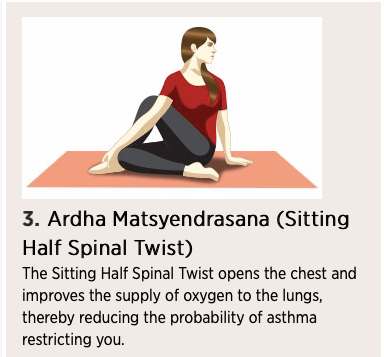



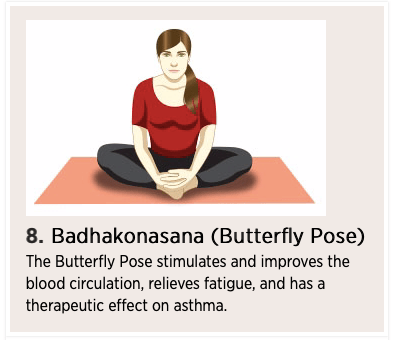
Monitoring asthma
Peak flow meter:
Peak expiratory flow (PEF) is the measure of how forcefully you can blow from your lungs. PEF helps to evaluate the extent of airway obstruction. The peak flow meter is measured using a simple instrument useful in measuring the functioning of your lung. The device has a mouthpiece, a cursor, and a measuring scale. PEF is useful in asthma diagnosis, to evaluate improvement, to evaluate how asthma medicines are working, and to adjust the medication by your doctor. PEF is useful for the following purposes.
- For the day-to-day recording of asthma severity
- To evaluate the Measuring PEFR progress of asthma
- During an asthma attack
- After taking asthma drug
Measuring PEFR
To measure Peak Expiratory Flow Rate (PEFR), you have to do the following steps:
Step 1: Set the cursor to 0
Step 2: Stand up and take a deep inhalation. Close your lips tightly around the mouth
piece to ensure there is no leak.
Step 3: Breath out as hard and forcefully as you can.
Step 4: Notice and record the reading (indicated by the cursor) on the measuring scale.
Step 5: Repeat steps 1 to 3 for 2 more times to take the best of the 3 readings.
You have to maintain the values in a book or paper. Your doctor will interpret and tell you the findings of PEF.

Asthma Diary
Maintaining an asthma diary helps you to keep track of your asthma control and medicines that you are taking.
Myths and facts about asthma
| Asthma Myth | Fact |
| Asthma is a temporary disease | Asthma is a chronic disease that affects people for life. Continuous treatment is essential |
| Inhalers are inferior to oral drugs | Inhalers may be difficult to carry or use but they are more effective and safe compared to oral drugs |
| Regular use of inhaler develops habit and effectiveness comes down | No inhaler is not addictive and it does not become a habit. The effectiveness also does not change. |
| Regular use of inhaler makes children dull and slows their growth | No, inhaler has no impact on growth or liveliness of a child |
| Inhaler medicine has a lot of side-effects | No, if the inhaler is properly used with proper drug and dose, most people do not develop any side-effects. |
| With the use of an inhaler, I have to alter my food habits | No, the use of inhalers has no effect on your food habit. However, taking a healthy diet will help to control asthma |
| Asthma is the curse of God | No, it is a disease of the abnormal immune response to allergy |
| Asthma is infectious and spreads from one person to other | Asthma is not infectious and it does not spread from one person to another |
| Alternate medicine can cure asthma | No, there is no cure for asthma. It can only be Controlled |
| Allergy testing can cure asthma | Allergy testing can identify things that you are allergic to, it can’t cure asthma |
| Asthma can’t kill a person | An asthma attack can be very fatal and in rare cases, it can kill. So one must visit the doctor ASAP in case of an attack. |
| Only children can get asthma | No, asthma can happen at any age |
| Milk and dairy products are bad as they increase mucus | Milk or dairy products do not increase mucus. Like any other food, moderation is important |
| You can’t exercise | If you have severe symptoms or an asthma attack, you can’t exercise. Otherwise, you can |
Conclusion:
Asthma is a condition that can be well controlled with medication and you can lead a normal life like any other person. However, you have to take medicines as suggested by the doctor, visit the doctor regularly, do yoga, do exercise, follow a healthy lifestyle, follow a healthy diet and keep a watch on your asthma and its symptoms. If you do all these, there is a very high possibility that you would lead a normal, active, and productive life as anyone else. Meet with Dr. Parthiv Shah is a Pulmonologist & Asthma Specialist in Borivali, Mumbai.

